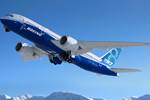Boeing 737-10 completes successful first flight
Per the successful flight, the largest airplane in the 737 MAX family begins comprehensive test program.

Boeing 737-10. Photo Credit: Boeing
On June 18, Boeing’s (Seattle, Wash., U.S.) 737-10, the largest airplane in the 737 MAX family which incorporates composites, completed a successful first flight. The airplane took off from Renton Field in Renton, Wash., at 10:07 a.m. and landed at 12:38 p.m. at Boeing Field in Seattle.
“The airplane performed beautifully,” says 737 Chief Pilot Capt. Jennifer Henderson. “The profile we flew allowed us to test the airplane's systems, flight controls and handling qualities, all of which checked out exactly as we expected.”
This flight was the start of a comprehensive test program for the 737-10. Boeing says it will work closely with regulators to certify the airplane prior to its scheduled entry into service in 2023.
“The 737-10 is an important part of our customers’ fleet plans, giving them more capacity, greater fuel efficiency and the best per-seat economics of any single-aisle airplane,” says Stan Deal, president and CEO of Boeing Commercial Airplanes. “Our team is committed to delivering an airplane with the highest quality and reliability.”
The 737-10 can carry up to 230 passengers. Boeing notes that it also incorporates environmental improvements, cutting carbon emissions by 14% and reducing noise by 50% compared to today’s next-generation 737s.
Related Content
-
Welding is not bonding
Discussion of the issues in our understanding of thermoplastic composite welded structures and certification of the latest materials and welding technologies for future airframes.
-
PEEK vs. PEKK vs. PAEK and continuous compression molding
Suppliers of thermoplastics and carbon fiber chime in regarding PEEK vs. PEKK, and now PAEK, as well as in-situ consolidation — the supply chain for thermoplastic tape composites continues to evolve.
-
Plant tour: Joby Aviation, Marina, Calif., U.S.
As the advanced air mobility market begins to take shape, market leader Joby Aviation works to industrialize composites manufacturing for its first-generation, composites-intensive, all-electric air taxi.
















